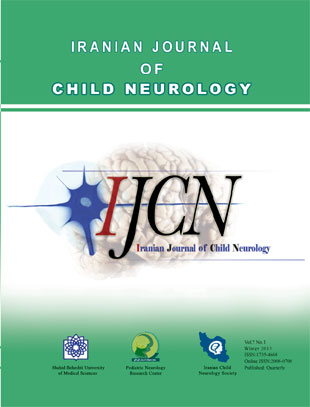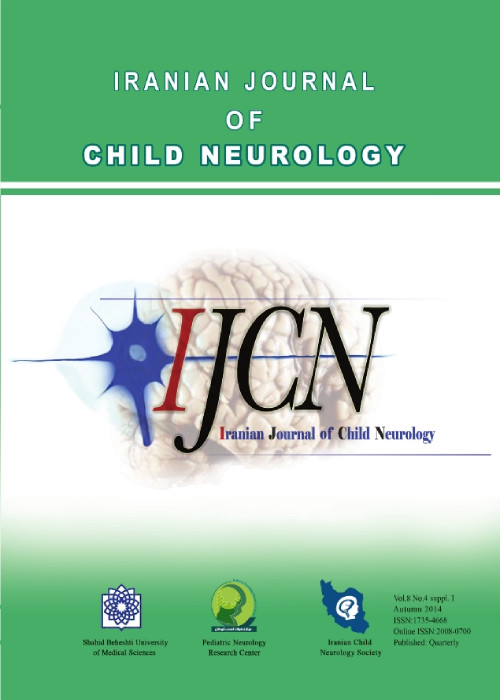فهرست مطالب

Iranian Journal of Child Neurology (IJCN)
Volume:7 Issue: 1, Winter 2013
- تاریخ انتشار: 1391/12/23
- تعداد عناوین: 8
-
-
Page 1Dementia in children or young adults is most frequently caused by neuronal ceroidlipofuscinoses (NCL), a group of incurable lysosomal storage disorders linked by the accumulation of a characteristic intracellular storage material and progressive clinical deterioration, usually in combination with visual loss, epilepsy, and motor decline. The clinical characteristics can vary and the age at disease onset ranges from birth to over 30 years. Diagnosis of an NCL is difficult because of genetic heterogeneity with14 NCL forms (CLN1- CLN14) identified and a high phenotype variability. A new classification of the disorders is based on the affected gene and the age at disease onset and allows a precise and practicable delineation of every NCL disease. We present a clear diagnostic algorithm to identify each NCL form. A precise diagnosis is essential for genetic counseling of affected families and for optimizing palliative care. As patient management profits from recognizing characteristic complications, care supported by a specialized team of NCL clinicians is recommended. The development of curative therapies remains difficult as the underlying pathophysiological mechanism remains unclear for all NCL forms.
-
Page 9ObjectiveHeadache is a common disabling neurological disorder and migraine comprises more than half the causes of recurrent headaches in children. Despite extended prevalence of this type of headache there is lack of evidence about best drug treatment for migraine. So we aimed to compare the therapeutic effects of these drugs on childhood migraine.Materials and MethodsIn the current study, a randomized clinical trial consisting of 78 patients according to 2004 International Headache Association criteria were randomly assigned to two groups that matched by age and sex. One of these two groups was treated with Topiramate, while the other was given Propranolol. After one and four months, the efficiency of these treatments was measured in terms of frequency, severity and duration of migraine attacks.ResultsResults obtained from the data collected showed that of these 78 studied patients, 38 patients received Topiramate treatment (group A) and the rest (40 patients; group B) wase treated with Propranolol. The average age of group A was 8.5± 2.9 years and that of group B was 8.3 ± 2.8 years. No significant difference was observed between these two groups in terms of reduction in frequency, severity and duration of migraine attacks.ConclusionResults showed that both treatments had the same efficiency in healing migraine headaches and there was no significant difference between their treating results. However, further studies are needed to examine medical effects of these two medicines
-
Page 15ObjectiveElectroencephalography (EEG) recording is a long duration procedure that needs patient’s cooperation for device setup and performing the procedure. Many children lose their cooperation during this procedure. Therefore, sedation and sleep are frequently induced using a few agents as pre procedure medication in children before EEG recording. We aimed to compare the sedative effects of oral midazolam versus chloral hydrate before the procedure along with their impacts on EEG recording in children.Materials and MethodsA randomized trial was carried out to compare the sedative effects of oral midazolam versus chloral hydrate and their impacts on EEG recording in children. A total of 198 children (100 in the midazolam group and 98 in the chloral hydrate group) were enrolled in the study and randomly allocated to receive either oral moidazolam or chloral hydrate.ResultsOral midazolam had superiority neither in sleep onset latency nor in sleep duration when compared to chloral hydrate. Moreover, the yield of epileptiform discharges in the chloral hydrate group was more than the midazolam group.ConclusionThe results of this study showed that both chloral hydrate 5% (one ml/kg) and oral midazolam (0.5 mg/kg) could be administered as a pre medication agent for EEG recording in children. However, oral midazolam at this dose had no advantage compared with chloral hydrate.
-
Page 21ObjectiveThere are controversial findings in the literature on the effects of chest physiotherapy on postextubation lung collapse in pediatric age group. Therefore, we aimed to investigate the efficacy of chest physiotherapy in prevention of postextubation atelectasis in pediatric patients.Materials and MethodsIn a case-control study from March 2007 to March 2011, two groups of patients (35 patients in each group) susceptible to lung collapse were enrolled in the study. The studied patients had neuromuscular diseases such as spinal muscular atrophy, Guillain-Barre syndrome, critical illness polyneuropathy/myopathy, and cerebral palsy. The patients were randomly divided into two groups (case and control); The case group underwent daily chest physiotherapy through vibrator and chest percussion and the control group was under supervision. In the latter group, the underlying disease was treated and the lung collapse was managed, if occurred.ResultsThe frequency of atelectasis was lower in the case group who received prophylactic chest physiotherapy compared to the control group (16.6% vs. 40%).ConclusionChest physiotherapy as well as appropriate and regular change of position can considerably reduce the rate of pulmonary collapse in pediatric patients
-
Page 25ObjectiveCentral Nervous system (CNS) malformations are one of the most important causes of global developmental delay (GDD) in Children. About one percent of infants with GDD have an inherited metabolic disorder and 3-10 percent have a chromosomal disorder. This study aimed to survey the frequency of brain structural anomalies and their subtypes among the variety of etiologic factors in children with GDD in our patients.Materials and MethodsThis study used the results of neuroimaging studies [unenhanced brain Magnetic Resonance Imaging (MRI)] of all children who had been referred for evaluation of GDD to outpatient Clinic of Pediatric neurology at Children’s Medical Center affiliated to Tehran University of Medical Science between September 2009 and September 2010.ResultsIn this study, unenhanced brain MRI was performed on 405 children, of which 80 cases (20 percent) had brain structural anomalies. In 8.7 percent of the cases, previous history of brain structural disorders existed in other children of the family and 20 percent of mothers had inadequate consumption of folate during pregnancy.ConclusionBased on the results of this study, unenhanced cranial MRI seems to be a fundamental part of evaluation in all children with GDD. Adequate folate consumption as prophylaxis as well as genetic counseling can be worthy for high-risk mothers who have previous history of CNS anomaly or miscarriage to avoid repeated CNS anomalies in their next pregnancies
-
Page 31ObjectiveDevelopmental impairment is a common problem in children health that occurs in approximately 5–10% of the childhood population. The aim of this study was to determine the etiologic yield of subspecialists’ evaluation of young children with developmental disability.Materials and MethodsAll children aged between 2 months and 5 years referred over a 15-month period to Hamadan University of Medical Sciences subspecialty services for initial evaluation of a suspected developmental Disability, were enrolled in the present study. Diagnostic yield was determined after the completion of clinical assessments and laboratory tests requested by the evaluating physician.ResultsA total of 198 children (129 boys and 69 girls) were eligible for our study.108 children had global developmental delay and 90 children had isolated developmental delay. Approximately ¼ of all patients did not have any specific etiology for developmental disability. Cerebral palsy (CP) was the most common clinical syndrome in all patients (41.4%). Hypoxic ischemic encephalopathy (13.8%), brain dysgenesis (13%), genetic disorder (13%), and neurodegenerative diseases (11%) were determined in more than one half of all children with global developmental disability. in our study, “developmental speech delay” was the common cause of isolated speech delay.ConclusionDetermination of an underlying etiology is an essential part of specialty evaluation of young children with developmental disability. The results of this study were similar closely to the results of other studies.
-
Association of Brucella Meningoencephalitis with Cerebrospinal Fluid Shunt in A Child: A Case ReportPage 37Brucellosis is an endemic zoonosis in Iran. It is a systemic infection that can involve any organs or systems of the body and have variable presentations. Ventriculoperitoneal (VP) shunt infections due to brucellosis have been rarely reported in the literatures. This is the history of a four years old boy who developed Brucella meningoencephalitis at the age of 42 months, whilst he had a VP shunt in situ for hydrocephalus treatment. Also, he presented brucellosis as acute abdomen. This patient was treated with trimethoprim-sulfamethoxazole, gentamicin and rifampicin. The shunt was extracted and all clinical and laboratory test abnormalities subsided through this management.We propose that in a patient with Brucella meningoencephalitis, the cerebrospinal fluid shunt system can be extracted and treatment with appropriate combination of antibiotics could be successful. Moreover, it shows that brucellosis should be considered in the differential diagnosis for acute abdomen and ascites in endemic regions
-
Page 41Joubert syndrome (JS) is a rare autosomal recessive central nervous system malformation characterized by hypoplasia of the cerebellar vermis,hypotonia and abnormal psychomotor development, along with altered respiratory pattern and various ophthalmologic features.Here, we describe three children with Joubert syndrome in a family that had almost similar presentations, including ataxia, developmental delay, mental retardation and ocular disorders.Prevalence of Joubert syndrome is about 1 in 100,000 live birth. It may be accompanied by other organs’ disorders. The molar tooth sign is pathognomonic for joubert syndrome that is ascertained by brain MRI


